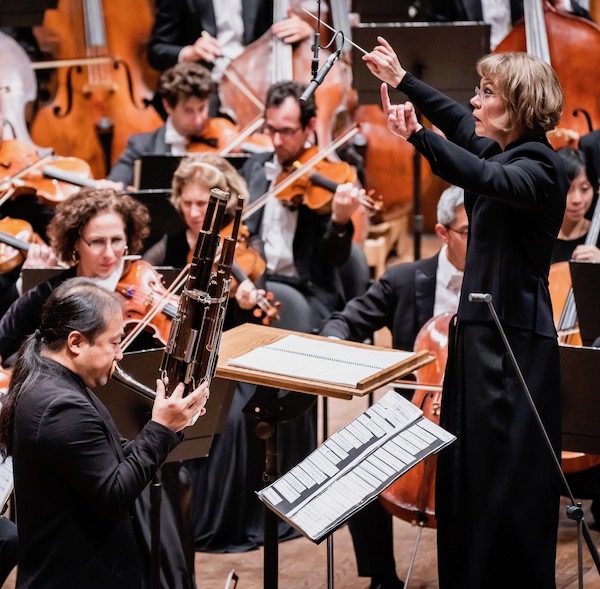Haydn, Strauss match wits in Mälkki’s Philharmonic program

In an inspired bit of programming, Friday’s concert by the New York Philharmonic under Susanna Mälkki featured a philosophical conversation across the centuries between, of all people, Joseph Haydn and Richard Strauss.
Haydn’s Symphony No. 22, “The Philosopher,” even opens with a striking four-note horn call not unlike the famous “Superman” motive of Strauss’s Also Sprach Zarathustra, which closed Friday’s program with a splash.
Even better from this orchestra’s point of view, Haydn instructs the French horns to play fortissimo while the rest of the orchestra plays softly, which is the Philharmonic horn section’s usual modus operandi anyway.
The symphony’s nickname, which came into use during Haydn’s lifetime, derives from the sober, musing Adagio with which it opens. As if to compensate for beginning a symphony so unconventionally, Haydn filled out the work with a sprightly minuet and two Prestos.
On Friday at David Geffen Hall the Philharmonic gave the symphony a respectable airing, a bit short of the clarity and coordination one has come to expect in performances of Classical-era symphonies these days. Conductor Mälkki’s taut, sweeping gestures, perhaps tailored more to Strauss than to Haydn, brought out some legato phrasing in the Adagio but allowed that movement’s prevailing staccato eighth-notes to tick along unshaped. In their prominent parts, two English horns played nicely but a hair late throughout.
The players dispatched the fast movements with energy and well-gauged dynamic shading, if less-than-ideal clarity and lightness. The two French horns suffered a few too many cracked notes, but showed considerable agility in taxing passages of the minuet and the Presto finale.
The concerto slot on the program was occupied by Šu, a one-movement work for sheng and orchestra by Korean-born Unsuk Chin, the most recent recipient of the Philharmonic’s Kravis Prize for new music. Although a commission for a new work is part of the prize, the orchestra chose to introduce the honoree with this 2009 piece featuring the ancient Chinese mouth organ.
The sheng resembles a bundle of sticks about a foot tall, with an air chamber underneath, played by inhaling and exhaling through a mouthpiece. Like its distant cousins the harmonica and the accordion, it is a “free reed” instrument capable of touching solo melodies and chugging chords.
Chin describes her compositions as “dreams,” and on Friday Šu began softly and molto adagio, with soloist Wu Wei’s high reedy notes clustering as wispy clouds drifted by in the strings. Cued by the attentive Mälkki, the orchestra’s large percussion battery intervened briefly at first, then drove the soloist to a frenzy of rapid choo-choo chords amid swirling woodwinds.
The piece closed in a gently pulsing adagio amid shifting clouds of cluster chords. In the slow sections as much as the fast ones, Wu Wei—who was also soloist in the piece’s premiere ten years ago—showed impressive lung power and breath control as he shaped singing lines and powered out big chords.
After the bows and a nice hand for composer Chin onstage, the lobby-bound audience was not exactly demanding an encore, but Wu Wei dashed onstage and played one anyway, a rhapsodic showcase for his instrument à la Liszt, beginning with a plaintive melody, then swinging into a frenzied, chugging dance.
The Philharmonic’s bright, brassy sound was right at home in Strauss’s Nietzsche-inspired tone poem, roaring out the opening fanfare and later rising to muscular climaxes at Mälkki’s fervent urging. Less expected was the sonorous string sound that emerged from the gloom following the fanfare.
The conductor drew vivid characterizations elsewhere as well, as in the fugue of the “Learning” section, raucous and threatening to spin out of control. A bit more lightness and Bavarian gemütlichkeit might have enlivened Zarathustra’s waltz, capably led by Sheryl Staples’s rubato-tinged violin solo, and also the closing passages for string quartet.
But on the whole, in this familiar piece, the Philharmonic played with the zest and coordination one missed in the Haydn. And conductor Mälkki drove that fast machine with all the panache one could ask for.
The program will be repeated 8 p.m. Saturday and 7:30 p.m. Tuesday. nyphil.org; 212-875-5656.